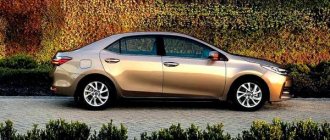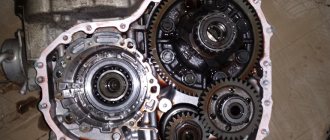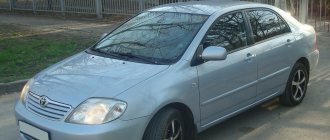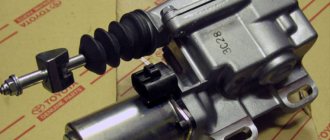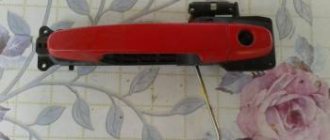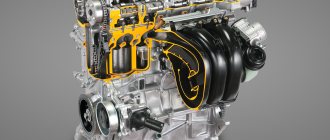Car appearance updates
The appearance of the 2011 Corolla body was created by Turkish and Italian designers. The modifications were extensive and affected:
- radiator grille shapes;
- Headlights;
- trunk lid;
- rear lights;
- both bumpers;
- reflective reflectors;
- dimensions.
On the front of the car, a special paint composition was applied to protect it from small stones and gravel. The sporty appearance of the new Corolla was made possible thanks to the elongated struts, which, in turn, increased the aerodynamics of the car and reduced fuel consumption. Some trim levels were additionally equipped with a sports aerodynamic body kit. The beautiful new look of the model was completed by 16-inch wheels. The car acquired a bright sporty style, which can be seen in the photo on the Internet.
Interior design
Fresh door colors make them look modern, and the new dashboard color scheme is easier to read. The design of the steering wheel on the Corolla S emphasized its sporty character, and its tilt adjustment made it possible for drivers of any height to control the car comfortably.
The front seats were designed taking into account the driver's characteristics, the second row of seats became more comfortable, and now three adults could sit there. An improved exhaust system frees up additional space in the cabin.
The main multimedia display began to reflect:
- external t (°C);
- consumable fuel;
- speed;
- mileage traveled.
The modified interior provides more space and is supplemented with:
- compartment in the center of the console;
- glove compartment;
- door recesses;
- cell for glasses;
- coasters for glasses.
The changes are noticeable in different photos.
Technical changes
Let's look at the technical characteristics of the 2011 Toyota Corolla. This model was equipped with a power unit with a V of 1.8 l and 132 l. With. The engine was equipped with intelligence for transforming valve timing stages, which stabilized engine operation. Thus, fuel consumption per hundred was 8.4 liters within the city and 6.7 liters on the highway.
The new 2011 Toyota Corolla for sale was presented with a five-speed manual transmission and a four-speed automatic transmission, which served as a complete replacement for a car with a 1.6 engine equipped with an automatic transmission.
The suspension units have also changed:
- front MacPherson struts were equipped with stabilizers;
- The rear beam is equipped with road roughness absorption structure.
The changes also affected the braking system:
- the front discs were replaced with ventilated ones;
- the rear ones are on the drums.
All 2011 Corolla models boasted a familiar reliability system that monitored:
- stability;
- slip warning;
- ABS and brake force distribution.
The characteristic dynamics and handling of the 2011 models have not undergone significant changes.
| Length, cm | 4.620 |
| Width, cm | 1.775 |
| Height, cm | 1.465 |
| Wheelbase, cm | 2.700 |
| Wheel track, cm | 1.535 |
| Salon length, cm | 1.930 |
| Interior width, mm | 1.485 |
| Salon height, mm | 1.190 |
| Trunk, l | 452 |
| Tank, l³ | 55 |
| Tires – R16 | 205–55 |
| Ground clearance, mm | 150 |
Advantages and disadvantages of the box
When choosing a car, the driver is always faced with the question of which transmission is better to choose, since at first glance it may seem that there is not much difference between them. By choosing any of the above, in addition to mechanics, the driver receives a number of positive aspects, such as:
- The chassis with the engine is protected from overloads;
- Smooth running of the car;
- There are no jerks at the start or when changing gears;
- Makes it easier for beginners to control;
- With careful use it has a long service life.
As for the disadvantages of automatic transmissions, these include:
- High fuel consumption compared to classic mechanics or a robot.
- If your driving style is active, then the automatic machine will have high operating costs, since you will need to change consumables and oil more often;
- Maintenance is more expensive than a robot.
Unlike a robot, an automatic transmission has a shorter resource, and due to higher engine speeds, gasoline consumption is higher. Judging by the reviews, the automatic transmission is excellent for powerful engines with high traction; such a transmission will feel especially good over long distances where high speed is required.
Important! If you are purchasing a car to cover long distances, then an automatic transmission is perfect for you.
It is precisely because of the lack of power that car owners change the robot to an automatic one.
Features of the car
The new generation Corolla cars had an improved safety system. The car was designed to disperse the impact of an accident over the entire body. And in a collision from the side, the force was redistributed to the lower part of the car.
Any configuration was supplied with:
- six safety pillows;
- head restraints for the front seats.
Drivers listed the positive and negative aspects of a brand new car. The advantages include:
- fuel efficiency;
- the latest European design;
- voluminous trunk;
- wide salon.
The disadvantages include:
- excessively wide stance;
- low motor power.
How to understand which gearbox is installed on a car
How can you find out, without studying the technical specifications, whether an automatic transmission or a robot is installed on a Toyota Corolla? Let's try to figure it out by observing how the machine behaves in operation.
When the car is moving, the automatic transmission switches to higher or lower speed when the required number of revolutions is reached, this is accompanied by:
- a small jerk (as during mechanical operation);
- high noise level;
- switching when reaching only 3.5 thousand revolutions.
When driving a car, a CVT transmission is characterized by:
- lack of switching;
- soft acceleration (changes the number of revolutions almost imperceptibly).
Being in a car with a CVT installed, you feel more comfortable, both driving through city streets and on the open highway.
Options
In the 2011 Toyota Corolla car market, three trim levels were offered:
- “CE” – base;
- “LE” – comfort;
- “S” – sport.
The initial configuration of “CE” included a mandatory set of functions and technical characteristics. The protection of the driver and fellow travelers was guaranteed by the operation of the following systems:
- traction adjustments;
- ABS;
- checking tire pressure;
- focusing braking force;
- exchange rate stability;
- emergency brake.
The novelty of the appearance of the “steel beauty” was visible thanks to:
- increasing mirrors;
- installation of 15-inch disks;
- block headlights with new dispersion;
- daytime running lights;
- door handles and radiator grille;
- updated color.
The salon was characterized by:
- fabric material of chairs;
- leather-trimmed steering wheel and gearshift lever;
- heating and cooling systems;
- audio system with 4 speakers;
- the ability to fold down the seats.
The “LE” package has been supplemented with:
- heated exterior mirrors;
- sound system with 6 speakers;
- lock control function;
- electric windows;
- main lock with automatic locking.
The “S” package was equipped with:
- 16-inch wheels;
- sports-style panels;
- halogen block headlights;
- combined fog lights.
Review of Toyota Corolla 1.6 (2011)
Hello everyone. I decided to write a review about my constant companion on the roads of the country.
I’ll say right away so as not to get into a squabble over the choice of car. I bought what I thought was necessary, I don’t need loans and a used car - this is for those poets who usually write: they say I would have added a little more and bought a better one or a used one u. I answer for you - chew and swallow.
I didn’t hesitate with the purchase. The amount was 800,000+/- 100,000 rubles. In 2011 I had a Mazda 3, 2008. An excellent device, I gave it to my brother, I wanted to try a Toyota and an automatic one. The choice immediately fell on the Corolla. I don’t like and won’t compare it with other cars (and there is something to compare with) to describe its interior to the touch, appearance, ergonomics, everyone can sit in a car dealership and decide everything for themselves. I’m always only interested in the technical side of the car and the exterior view. The simpler the car, the less whining about breakdowns. I don’t consider turbo engines at all, the rear suspension is only on the beam. It’s bad that now electric power steering is mostly used instead of hydraulic power steering. The equipment is not particularly important to me, the main thing is heated seats, electric windows, mirrors and air conditioning. Everything else is toys and pampering. My Mazda 3 was at maximum speed, there were definitely a lot of unnecessary things there. And so.
Engine.
It is quite enough for the driver and passenger both on the highway and in the city. I am not a racer, but I test every car at its maximum speed, it goes 100% at 180 km/h, no more and no less. (That’s how it is for me). Up to 140, if the gas is to the floor, it picks up quickly, the engine is audible after 3000 rpm, the noise is weak, the Japanese don’t bother with it. Now, of course, I have a Shumka installed, but I can still hear the engine, although there is no noise from the road and wheels up to 120 km/h. it’s all due to savings on the thickness of glass and metal. With air conditioning and a full interior, the dynamics are no longer the same. You don’t need to expect much from 124 hp, but at speeds of 80-140 you won’t feel disadvantaged if you don’t try to overtake cars in 200 meters to the oncoming meeting. the engine has a chain mechanism, only one drive belt on the generator is changed, and that one without a tensioner, this is a huge plus. Buy yourself a spare belt for 500 rubles. and forget about replacing it, I haven’t changed it yet. This motor has one significant drawback - its maintainability. It has no reserve for boring, the block needs to be replaced. But I hope this is very far away.
In case of repair, injectors are expensive, around 8,000 apiece, so keep an eye on them and wash them again every 30,000 km; if you haven’t washed them, like me, until 90,000, then don’t touch them, it will be much worse. I cleaned the intake flap myself, everything was easy to disassemble, there was a decent amount of carbon deposits for such a mileage, but there were no malfunctions. The fuel filter costs around 5,000 rubles assembled, but without a pump, but you can buy only the filter element and mesh separately, all together about 1500 rubles. Consumption with my driving if one is 100-140 km.h. - 8 liters. If I’m driving with my family at 90-100 km/h, the computer says 7 liters, so 1 liter of difference is not an indicator. I have never seen a city 11.5-12.5 higher than these marks on a transmission. Of course, I would like a more powerful engine for it, so 1.6 is not for racing, I tell you right away, especially with an automatic transmission. doesn’t eat oil, I pour Toyota oil in an iron canister, in the summer 5W30 in the winter 0W20, I change it myself every 5000 km + all filters, I refused the warranty right away, this is not for me, but in Toyota you still need to prove that every breakdown is a warranty case. me I’m surprised by the people who write that like Toyota requires a service interval of 10,000 km, I’ll tell you that this is written by people who don’t understand anything about cars in general. 15,000 km, especially 20,000, no oil in the world can withstand. These are the kind of riders then and whine that their engines are replaced under warranty, in short, laughter and that’s all. In the city, you generally need to count not mileage, but engine hours. so for a city 5000 km is just right.
Automatic transmission. the gearbox is the simplest, 4-speed, a regular torque converter, the most proven and reliable mechanism, with the ability to select a manual transmission, and not like tiptronics and other similar things on automatic transmissions, and indeed everything else (such as DSG, CVT, robots and gearboxes with 6-7-8 gears) — herabora, except for hemorrhoids they do not give anything, neither fuel economy, nor smoothness, I have tested this on other cars and this is my final opinion and no one will convince me of this. This box can be made at any service center and without great expense. The box itself switches with minimal jerks, there are some, that’s for sure, but the smoother the acceleration, the less sensitive they are. There are pauses when switching to a lower gear, the gearbox is adaptive, it is especially felt when leaving the city on the highway, but everything is cured by switching to third gear manually, five minutes and it is already ready for another mode. I assure you, this all happens much faster than I did I describe. it’s the same on the highway, you need to accelerate, you don’t have to push to the floor, as many “drivers” do, with one movement of your hand to the left and now there are three gears and the car drives completely differently. For racing, take a manual.
Suspension. the simplest, the fewer levers, the less costs. In the rear there is nothing to change at all, except for the struts. The front - everything changes in parts, balls, silent blocks in the levers. and so on. The cost of these spare parts is not affordable, like replacing assemblies on many other cars. Silent blocks for 700-800 rubles are original, the ball is not original. from 500 to infinity, racks orig. 5000 rubles each is expensive, but there are cheaper ones. The only bad thing is that the wheel bearings are replaced only with the hub. Their price is around 7000 rubles. The suspension itself is soft, but on the highway it doesn’t sway to the sides, you have to steer in ruts, it doesn’t shake in the pits, but it gives a little to the steering wheel, the steering rack taps almost again, just like on the Mazda 6.3, which also has electric power steering. For me, of course, the Mazda 3 is ideal in driving, but the price to pay for this is a wooden suspension. To summarize: I like the Toyota for its smooth ride, it’s soft, it doesn’t shake, but it rolls when turning; this drawback can be solved simply by releasing the gas. The steering, of course, is not the standard, it is not sharp enough, but the steering wheel obeys, where it turns, it goes there. This suspension will suit a person, a family man, who has already driven other cars, and wants to drive smoothly and comfortably from point A to B. This car is not for racing, there is no drive in it.
The brakes are soft, there is no sharp deceleration, sometimes it seems that you can’t slow down. You won’t be able to brake right away at high speeds. There is an EBD-type brake booster, but I didn’t understand the logic in the work; from 140 I couldn’t stop quickly, although I already I stepped on the brake pedal with both feet, but I didn’t feel any sudden deceleration, so don’t try your luck with these “helpers,” and know that the brakes are weak and it’s not the pads, by the way. the original was worn out in the city for 24,000 km, I bought not the original, for 2500 front + rear, I stopped driving to work, only rarely in the city, mostly on the highway and the next replacement was at 85,000 km. This is how changing the driving mode affects the service life of parts. To summarize: at high speeds you can’t brake right away, you need to get used to them and brake, if possible, a little earlier. Don’t sit under the ass of a passing car.
I won’t write about the interior and the quality of the parts, it doesn’t matter to me, I won’t be hysterical if I find hard plastic on the doors or hear a cricket in the panel, and I won’t give dealers shit about it. just go to the salon yourself, touch, sit, look around and you’ll understand everything for yourself. Well, it’s stupid to write about plastic and ergonomics in reviews. We’re all different, some don’t give a fuck... about plastic, but some don’t, some are comfortable sit, but someone doesn’t and it’s stupid to trash the car based on these indicators, read and think that because of this Corolla is shit. You need to tear off the fifth point, go to the salon, look at everything, and then read reviews about specific shortcomings in the operation of the chosen you models.
So, to summarize, I will say the following: I am 100% satisfied with the car. It is simple and reliable in everything, you can do the repairs yourself. This is not a racing option, there is no enthusiasm in it, there are other cars for that. It is soft on the move, easy to drive, the only costs were for oil and consumables (ugh, ugh, ugh). It is suitable for a calm, family man, without showing off and other crap in his head. The trunk is still too small, I had to buy a cane stroller, if the children are still very small, and if there are also two of them, then traveling with your family and suitcases is cramped. I bought it when I didn't have a child. I'm used to traveling with the little one and taking everything he needs: strollers, swings, toys, etc. Otherwise, she suits me. She is not ideal and I cannot recommend buying her, but it is a fact that she always brings me luck and does not suck money out of me. You need to drive calmly, don’t needlessly tear up the car, don’t jump over recumbents, and change everything on time, then it will serve properly. I had three cars from the showroom and I always looked after them and never did anything to them, like many people. You don’t need to crap on a car if you don’t invest in it and tear it up every minute, then you chew snot and shout that (even if it’s the same Toyota Kroll) shit.
If my review doesn’t work, it’s better not to write anything, I’ll answer questions with pleasure. Everything is written truthfully, nothing was made up.
Well, for the young guys and nerds who will write that I haven’t tried anything else except Toyota, here are all my cars that I have owned since 1998.
VAZ 2106, Audi 100/45, Volvo S80 2.9 2005 turbo, Mazda 3-1.6 Mazda 6-1.8; Honda CR-V 2.0 - 2005, Audi A4 - 2012 - working, Tuareg 2.5 diesel - working, Grand Vitara 2.0, Tiguan 2.0 petrol. Toyota Corolla.
